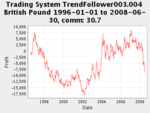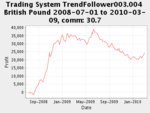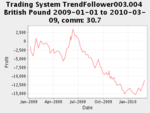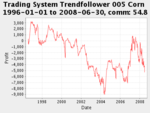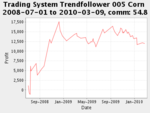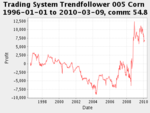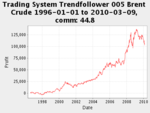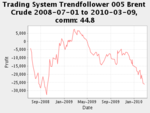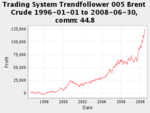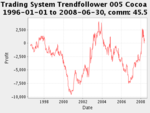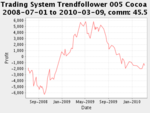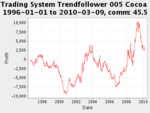You're quite right about the CAD and AUD and even the CHF, but definitely forget the EUR:GBP. I've checked it out a few months ago, because I wanted to trade it discretionary, and there's like 100 contracts traded every day.
This the EUR:
http://futuresource.quote.com/chart...&o=&a=D&z=800x550&d=LOW&b=CANDLE&st=VOI(1,1);
This is the EUR/GBP CME future (I don't remember the symbol):
http://www.cmegroup.com/CmeWeb/html.wrap/daily_bulletin/gbulletin_current.html
On the link above for some reason the EUR is listed as 50k contracts rather than 300k, which is more the case, but anyway the EUR/GBP is listed as having 82 contracts traded. Even if you multiplied that by 6, you'd still have a pretty poor volume.
There! I found a good measurement of volume on the CME chart, which lists it exactly at a few hundreds contracts per day, as I expected:
http://www.cmegroup.com/popup/mdq2...._2010_EUR_GBP&type=p#study=VOI;bartype=CANDLE
REGRET AND PLAN
I've got a big problem with not having developed systems on those, big regret. Because I do have the data, and if I traded them, I wouldn't have have just 40 systems but 60, and my diversification would be awesome. Also the DX should be traded. Actually you gave me an idea, and I am right now considering whether I should indeed build another 20 systems. If my eyesight assists me, I will. Another problem is that excel is the most tiring program for your eye-sight. You see, I created a structure for just 10 systems, and somehow I managed to fit 40 systems into it, into one page. If I expand the systems to 60 or more, I will not be able to look at systems at once any more.
Other than these issues and my fatigue, there's no other factors that could stop me from doing this. Here's the steps I will follow:
1) find out for sure which currencies futures are most traded and focus on the first 4 or 5 which I am still not trading
2) gather the necessary data, and, if necessary, buy symbols.
3) test previous systems on the new data, and adapt them where necessary
4) automate the systems
This will take me months (one month for testing, one month for automating) but it is something I must do. I just told you how important diversification is, and I can't waste the opportunity to diversify more, especially after I re-read yesterday the part where Schwager was summarizing Larry Hite's trading (in red the relevant part):
Let's hypothesize that we only allow each system to risk 1% of our equity. If margin allowed us (since we're trading futures), we would want our capital and systems to be continually busy, producing 1% risk bets. If each system produced on average 1 bet per day and we had no margin concerns, which we do not and I'll later explain why, we would want 100 systems to be trading. The reason we don't have margin concerned is that more or less, if one CL contract is making me risk 2000 dollars, or hypothetically more (because the biggest loss, as you said, is always in the future), it so happens to be that its margin is also around that value. If the ZN is causing me a risk of 500 dollars, its margin required is not that small, but close, in the case of intraday margin. In fact, this happens because margin was defined based on risk. They require you to have
more margin than you can lose in one day with a given future. On average, about twice as much. I am thinking out loud.
So that would mean that I can... these formulas are getting too complicated for my small brain. It's overheating.
What I do know is that, even now, my capital is not busy all the time, so more systems can only help, by increasing profit and reducing drawdown or at least keeping it more or less the same. Anyway, I can't see all the implications of this, but definitely more systems is a good thing. And more futures always means more systems, because you can usually apply the systems you're running on other futures, on the new futures, and they will work.



